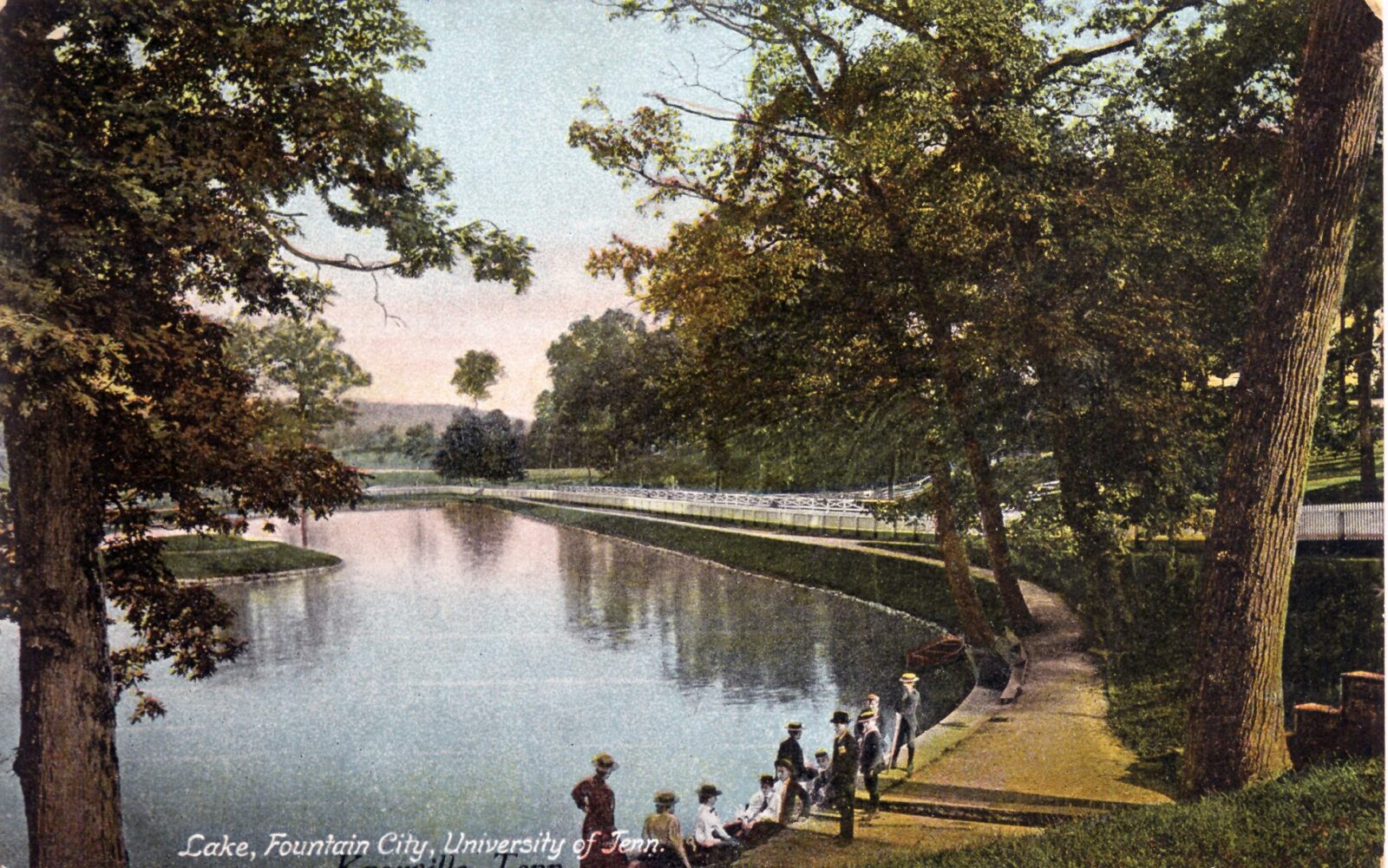With her usual exemplary style, fellow KnoxTnToday.com author Shannon Carey covered the present status of Fountain City Lake in an article entitled “Fountain City Lake work resuming soon, sediment removal added to project” (dated Sept. 5). Highly recommended!
Since the publication of my newest book “Fountain City: People Who Made a Difference” last year, I have been asked to do eight or 10 book reviews and one of the most frequent questions during Q&A has been, “What is the history of Fountain City Lake?”
There was a reason that Fountain City was originally called Fountain Head as there were many springs in the basin between the two ridges, Black Oak Ridge to the north and Sharp’s Ridge to the south. The expert on the matter is my friend John Burka who was the chief engineer for the Fountain City Water Co. He says that the flow from the spring that supplies the lake was the major source for the water company in its early years and that the flow was much greater back then.
In fact, Burka says, “You could dig a hole any place in the basin and water would rise in it.”
When the water company was founded in 1931, almost all of the water consumed by the 1,400 homes and businesses in Fountain City came from the Lake Spring, the Hall Spring and a well on Essary Road. That consumption was 1 to 2 million gallons per day. As the suburb grew, a 16-inch main was connected through an auxiliary pumping station so that additional water could be purchased from the Knoxville Utilities Board.
Interestingly, Burka says the water company president M.L. Brickey made a study of the supply and found the aquifer’s source was near Bristol, making an understanding of the ebbs and flows of water over the years a complicated matter indeed.

Central Fountain City (Circa 1893). An early lithographed letterhead for the Holbrook Normal College is the earliest known representation of Central Fountain City. It pictures the marshy area alongside the Fountain Head Railway track where the lake would be impounded in 1894. (Courtesy of Dr. Paul J. Phillips, enhanced by Charles A. Reeves)
A small, thumbnail-size letterhead for the Holbrook Normal College (1893-1900) (see photograph), which Reeves Maps has enhanced, dates to about 1893. It shows the marshy area in front of the 1845-built white frame church, the Fountain City United Methodist Church. The church faced to the east toward present-day Broadway at the time but was replaced by a red-brick sanctuary facing Hotel Ave. as the 1957-built church does today. The lithograph shows the plat which is now occupied by Fountain City Lake in the lower left foreground.
This abundance of water and a marshy 1 ½ acres of unproductive land must have triggered Col. J.C. Woodward’s vision of the expanded resort. Having successfully managed and then sold his horse farm at Versailles, Ky., and having sold his mansion and Woodward Heights subdivision in Lexington, Ky., he moved to Fountain Head in 1890 and founded the Knoxville and Fountain Head Land Company. It purchased 431 acres at a cost of $159,600 which included the park and lake parcels and an additional 14 acres and the Fountain Head Hotel itself for $27,500.
Advertisements for Woodward’s 40-50 room Fountain Head Hotel boasted, “25-minutes ride from Knoxville on Fountain City cars, open all year around, magnificent springs and fine park, $2 per day, special rates for families.” Resorts and spas were in vogue at the time and his extensive properties provided the opportunity Woodward needed to expand into what would become the Fountain Head Hotel and Resort.
The amenities were deluxe for the time.
Mary Donahue, the future pastry chef at the Atkin Hotel on Depot Street and Gay, was manager of the dining room which served a multi-course evening meal for 50 cents. After dinner, guests were treated to an evening in the park. At 6:30 p.m., Professor Guilliani’s Italian band led a procession down the steps and into the park for a concert at the dance pavilion. As an alternative, couples could take a walk under the gaslights in the park and sit a while in the gazebo. About all that was needed was a convenient place to swim and to boat.
The colonel’s vision for the resort included the beautiful heart-shaped lake and he had the wherewithal to implement it. He contracted with Felix G. Phillips (1853-1938), a prominent local civil engineer and three-time Knox County engineer, to accomplish his plans.
Robert McGinnis’ “Tidbits of the Past: 1892-1895, Vol. III (2011)” describes the project as published in the Knoxville Tribune on April 8, 1894:
When (Col. Woodward’s) Fountain City Land Company says it is going to do anything, it generally does. The latest scheme devised by this company in order to make its property more attractive and a popular resort for pleasure seekers, is the large lake now being excavated near the famous Fountain City grove. The lake will be triangular in shape (later amended to heart-shaped) and cover an acre and a half of ground. …
The course of the spring in the park has been changed and the water will be furnished by the mammoth spring next to the post office. This spring will be rocked up several feet so as to not be covered by the lake. …
The banks are to be beautifully ornamented with shrubbery and it will be enclosed by a fence. … Engineer Phillips has charge of the work and Messrs. Rule and Kindell have the contract for the dirt work and masonry. They will excavate about six feet and the water will stand about four feet. … The contract price for the lake is $5,000 besides the many other improvements to be made.”
By June 1, 1894, a romantic heart-shaped lake was complete with a gravel walking footpath surrounding it. A white picket fence and gaslights completed a dream attraction for its time. Sometime later William E. and Dossie Miller Cooper added a carousel beside the wide walkway between the lake and the park and someone established a mini-zoo.
The Fountain Head Hotel and Resort became the local destination place for a time.
(Author’s Note: Thanks for assistance with the text and the graphics: John M. Burka, Robert A. McGinnis and Charles A. Reeves.)


